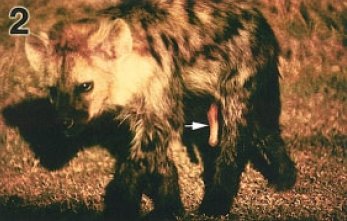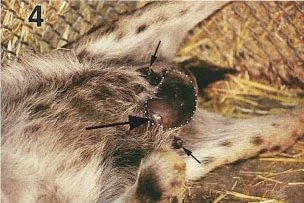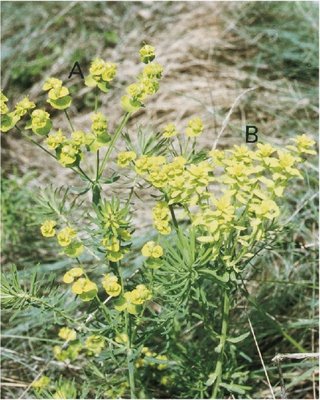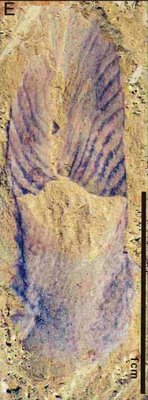In the current issue of
Nature (
27 April 06) there is an interesting article about the reason that female Spotted hyaenas (
Crocuta crocuta) are exposed to very high levels of androgens such as testosterone during the later stages of pregnancy. The answer seems to be that high levels of androgens pass on high status to the offspring of high status females. It also seems to promote aggressive and dominant behavior such as mounting (1).
This seems to be related to the extremely odd reproductive behavior and anatomy of hyenas, although the precise relationship is still a mystery.
It has long been noted that female hyaenas have very unusual genitalia with the females having an enormously enlarged clitoris giving the appearance of having male genitalia. They even have pseudo testes increasing the resemblance (2).

A female hyaena with a arrow pointing to the peniform clitoris
This structure is referred to as the ‘peniform clitoris’ :

The dissected reproductive organs of a hyaena
This would appear to be a complete mystery as this imposes a variety of costs throughout life. It makes copulation extremely difficult as intromission has to occur into the enlarged clitoris (!) if mating is difficult that is nothing to giving birth:

“Toward the end of an extended period of labor, a fetal hyena fills and stretches the clitoris (outlined by white dots) of a primiparous female. The clitoral meatus (large arrow) will eventually tear and permit birth to occur. Subsequent deliveries, through the stretched and torn clitoral meatus, are much more rapid. Note nipples (small arrows).” (2)
At least thing get slightly better with further births although I shouldn’t imagine that is much consolation for the hyaena. In fact, about 60% of first births are stillborn in a captive colony due to this peculiar anatomy; in the wild it could be even higher.
There seems to be two different processes that give rise to the female morphology. The development of the peniform clitoris begins early in development before the late burst of androgens. This shows that it is not a side effect of dominance conferring androgens. It seems like this particular avenue of development has been selected for because it is beneficial in itself. Although high levels of androgens are necessary for the complete development of the peniform clitoris (3) so there is probably some sort of co-evolution.
If there are such heavy costs of this morphology then why does it exist? There are several theories, it is probably partly to do with the increased dominance, aggression and possibly other thing like increased size/muscle mass. But there could be increased dominance without the peniform clitoris so it is likely that it has a benefit in itself, this could be because there is a lot of aggression towards young female hyaenas from siblings adult females and members of other clans and the enlarged clitoris could act to fool other hyaenas into not harming the young females (4).
Refs:
1) S. M. Dloniak, J. A. French and K. E. Holekamp
Rank-related maternal effects of androgens on behaviour in wild spotted hyaenas
Nature 440, 1190-1193 (27 April 2006) doi:10.1038/nature04540
2) Cunha GR, Wang YZ Place NJ, Liu W, Baskin L, and Glickman SE. (2003). The urogenital system of the female spotted hyena ( Crocuta crocuta ): a functional histological study.
J Morph 256:205–218. (PDF)
3) Cunha GR, Place NJ, Baskin LS, Conley AJ, Weldele ML. Cunha TJ, Wang YZ, Cao M, and Glickman SE. (2005). The ontogeny of the urogenital system of the spotted hyena (Crocuta crocuta Erxleben).
Biol Reprod 73:554-564. (PDF)
4) Muller MN & RW Wrangham.
Sexual mimicry in hyenas.
Quarterly Review of Biology. 77:3-16. (PDF)







